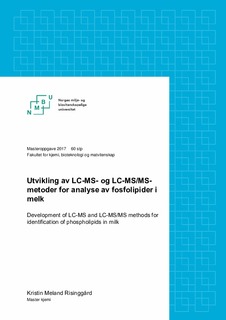| dc.contributor.advisor | Ekeberg, Dag | |
| dc.contributor.advisor | Devle, Hanne | |
| dc.contributor.author | Risinggård, Kristin Meland | |
| dc.date.accessioned | 2017-09-11T08:36:34Z | |
| dc.date.available | 2017-09-11T08:36:34Z | |
| dc.date.issued | 2017 | |
| dc.identifier.uri | http://hdl.handle.net/11250/2453970 | |
| dc.description.abstract | Melk er den første næringen pattedyr får, og inneholder viktige næringsstoffer som proteiner, fett og laktose. Mesteparten av fettet finnes som små kuler i melken, og membranen til disse kulene sørger for at fettet er delvis emulgert. En viktig komponent i membranen er fosfolipider, og innholdet av fosfolipider i melk har blitt undersøkt mange ganger tidligere med ulike teknikker.
I denne oppgaven ble LC-MS- og LC-MS/MS-metoder for analyse av 42 forskjellige fosfolipider fra fire forskjellige fosfolipidklasser i melk utviklet. Det ble etablert en rask metode for prøveopparbeidelse der melkelipidene ekstraheres med en løsning av kloroform og metanol (2:1, v/v). Fosfolipidene ble separert på en HILIC-kolonne med 5 mM vandig ammoniumacetat (A) og acetonitril med 0,1% eddiksyre (B) som mobilfaser. Det ble brukt en lineær mobilfasegradient med økning fra 2-21% A i løpet av 40 minutter.
Forut for LC-MS-analysene av melk ble en allerede etablert offline SPE-GC-MS-metode benyttet for å innhente fettsyreprofilen til de polare lipidene. Analysen viste at de mest dominerende fettsyrene var C16:0, C18:1n-9, C18:0 og C18:2n-6. De mettede fettsyrene utgjorde 61,2%, de enumettede 32,9% og de flerumettede 5,9%. Informasjonen ble brukt som støtte ved identifikasjon av fosfolipidforbindelser etter LC-MS-analyse.
Valideringen av metoden viste en matrikseffekt for de fire klassene ved 0,5 µg/mL fosfolipid på mellom 120 og 170% og 80,6 og 93,8% ved 100 µg/mL fosfolipid. Presisjonen til metoden hadde RSD under 6,5%, og carry-over ble kun observert for PC og LPC med verdier under LOQ. Interdag-variasjonen viste for melkeprøver RSD under 6,5% ved 50 og 100 µg/mL tilsatt standard. For å oppnå mindre matrikseffekt bør prøvevolumet økes.
Fosfolipidene ble detektert av en ionefelle i positiv modus, og den lave oppløsningen gjorde det nødvendig å benytte MS/MS til sikker identifikasjon. Det ble brukt multi-SIM-metoder med m/z-verdiene til alle ionene i analysene, og deteksjonsgrensen var 0,2 µg/mL for PC, 0,05 µg/mL for PE og 0,5 µg/mL for SM og LPC. Av de 42 fosfolipidene som ble identifisert var 67% av totalkonsentrasjonen PC, 30% SM, 1,6% PE og 0,93% LPC. De store konsentrasjonsforskjellene mellom PC, SM og PE var ikke forventet. De mest forekommende fosfolipidene var PC C16:0/C20:4, PC C16:0/C18:1, PC C16:1/C18:2 og SM C18:0/C20:0. | nb_NO |
| dc.description.abstract | As the first nutrition a mammal gets, milk contains important nutrients like proteins, lipids and lactose. Most of the lipids exist as globules in the milk, and the globule membrane keeps the lipids partially emulsified. Phospholipids are an important component of the membrane, and the phospholipid content in milk has been studied using various techniques on several occasions.
A LC-MS and LC-MS/MS method for identification of 42 phospholipids from four phospholipid classes in milk was developed. A rapid sample preparation where the milk lipids were extracted by a mix of chloroform and methanol (2:1, v/v) was established. The phospholipids were separated by a HILIC column, using 5 mL aqueous ammonium acetate (A) and acetonitrile with 0.1% acetic acid (B) as mobile phases. A linear mobile phase gradient was used, increasing from 2-21% A within 40 minutes.
Prior to the LC-MS analyses of milk, an already established offline SPE-GC-MS method was used to obtain the fatty acid profile of the polar lipids. The analysis showed that the predominating fatty acids were C16:0, C18:1n-9, C18:0 and C18:2n-6. The saturated fatty acids accounted for 61.2%, the monounsaturated 32.9% and the polyunsaturated 5.9%. The information was used as a support for the phospholipid identification after accomplishing LC-MS analysis.
The method validation showed matrix effects for the four phospholipid classes between 120 and 170% at 0.5µg/mL and 80.6 and 93.8% at 100 µg/mL. The method precision had RSD below 6.5%, and carry-over was observed only for PC and LPC with values below LOQ. The interday variation showed a RSD for milk samples below 6.5% with 50 and 100 µg/mL added standard. To obtain smaller matrix effects, the sample volume should be increased.
Phospholipids were detected by an ion trap in positive mode, because of the low resolution it was necessary to use MS/MS for reliable identification. Multi-SIM methods containing all the m/z-values of the ions in the analysis were used, and the detection limit was 0.2 µg/mL for PC, 0.05 µg/mL for PE and 0.5 µg/mL for SM and LPC. Of the 42 phospholipids identified, 67% of the total concentration was PC, 30 % SM, 1.6% PE and 0.93% LPC. The large concentration differences between PC, SM and PE was not expected. The most occurring phospholipids were PC C16:0/C20:4, PC C16:0/C18:1, PC C16:1/C18:2 and SM C18:0/C20:0. | nb_NO |
| dc.language.iso | nob | nb_NO |
| dc.publisher | Norwegian University of Life Sciences, Ås | nb_NO |
| dc.rights | Attribution-NonCommercial-NoDerivatives 4.0 Internasjonal | * |
| dc.rights.uri | http://creativecommons.org/licenses/by-nc-nd/4.0/deed.no | * |
| dc.subject | LC-MS | nb_NO |
| dc.subject | LC-MS/MS | nb_NO |
| dc.subject | HILIC | nb_NO |
| dc.subject | FAME | nb_NO |
| dc.subject | GC-MS | nb_NO |
| dc.title | Utvikling av LC-MS- og LC-MS/MS-metoder for analyse av fosfolipider i melk | nb_NO |
| dc.title.alternative | Development of LC-MS and LC-MS/MS methods for identification of phospholipids in milk | nb_NO |
| dc.type | Master thesis | nb_NO |
| dc.description.version | submittedVersion | nb_NO |
| dc.subject.nsi | VDP::Matematikk og Naturvitenskap: 400::Kjemi: 440::Analytisk kjemi: 445 | nb_NO |
| dc.subject.nsi | VDP::Matematikk og Naturvitenskap: 400::Kjemi: 440::Organisk kjemi: 441 | nb_NO |
| dc.source.pagenumber | 86 | nb_NO |
| dc.description.localcode | M-KJEMI | nb_NO |

